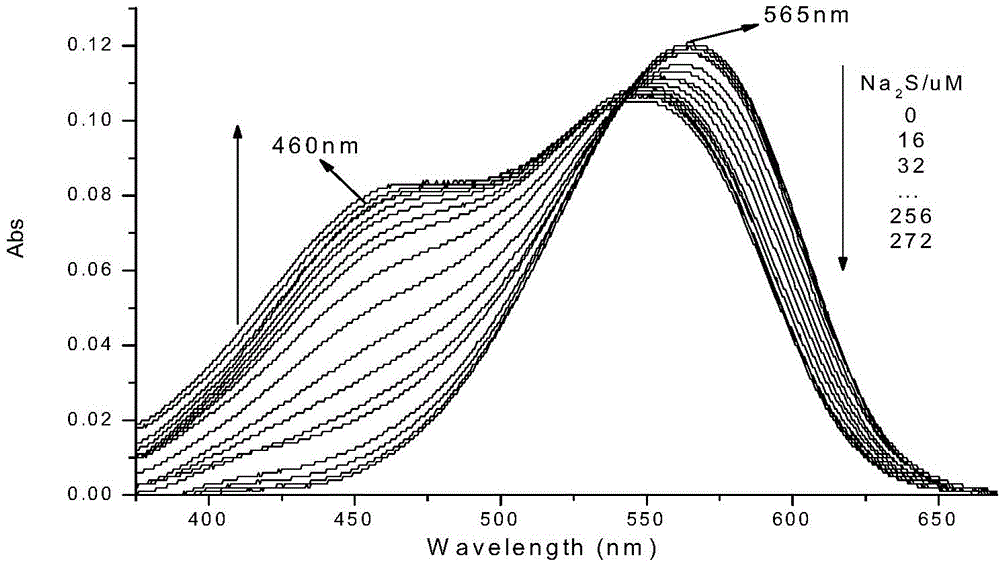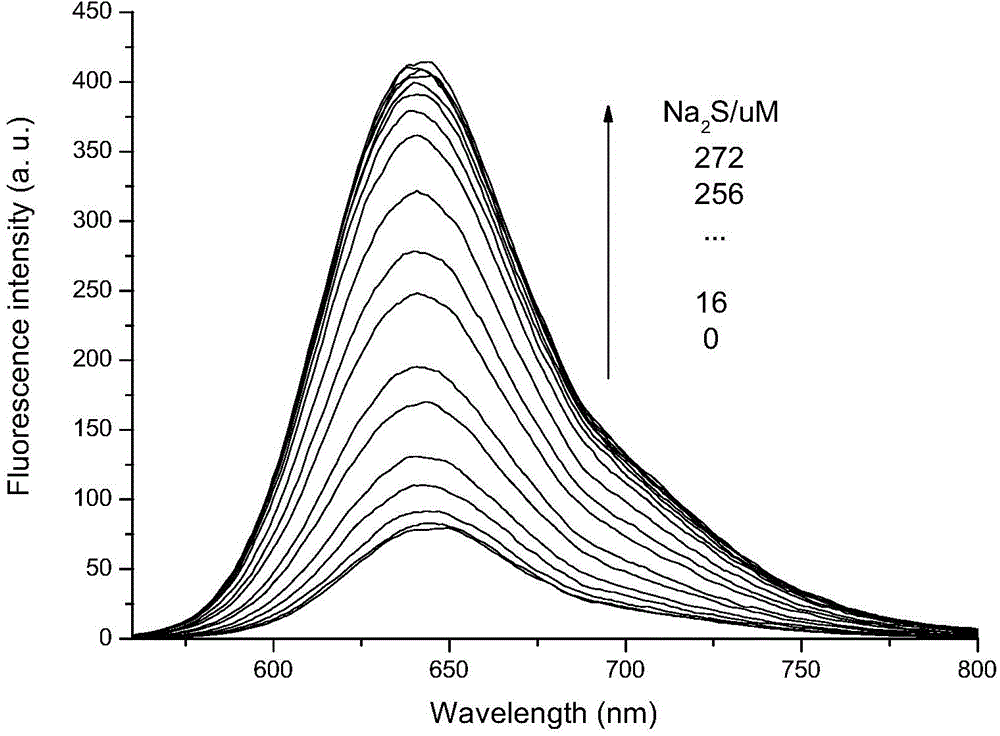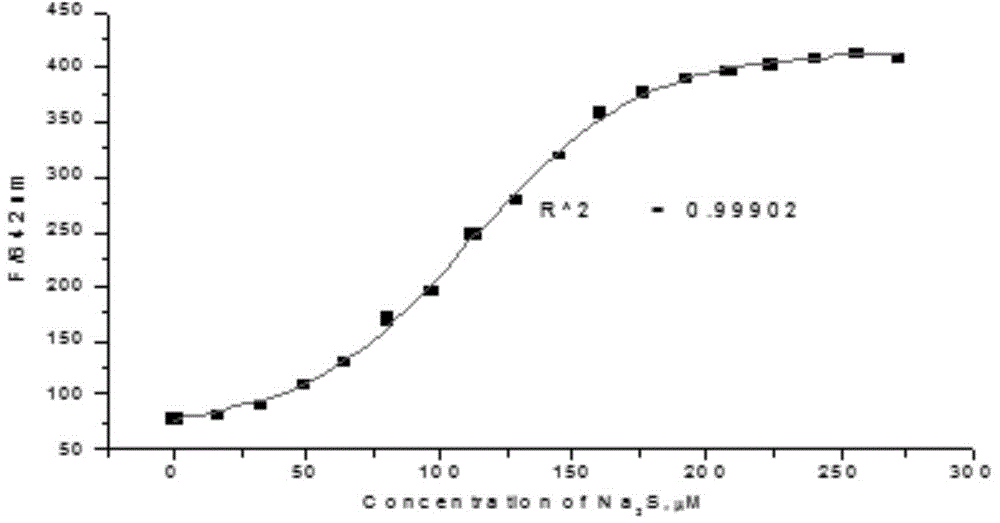Preparation method and applications of enhanced type fluorescent probe for detecting hydrogen sulfide
A fluorescent probe and hydrogen sulfide technology, applied in the field of fluorescent probes, can solve the problems of inability to detect hydrogen sulfide and have no mitochondrial localization function, and achieve the effects of good optical stability, no toxic side effects, and high selectivity.
- Summary
- Abstract
- Description
- Claims
- Application Information
AI Technical Summary
Problems solved by technology
Method used
Image
Examples
Embodiment 1
[0023] Implementation 1 A method for preparing an enhanced fluorescent probe for detecting hydrogen sulfide
[0024] The preparation reaction formula is as follows:
[0025]
[0026] Among them: Nile Red (9-(dimethylamino)-2-hydroxy-5H-Benzo[a]phenoxazin-5-one) is commercially available in the United States and can also be synthesized.
[0027] Nile red (0.0183g, 0.06mmol), 2,4-dinitrofluorobenzene (0.0135g, 0.072mmol) and K 2 CO 3 (0.0099g, 0.072mmol) was dissolved in 8mL dimethylformamide (DMF), heated to 75°C, and refluxed for 3h. The reaction solution was poured into 50 mL of water, extracted with dichloromethane (50 mL×3), the organic phase was collected, dried over anhydrous magnesium sulfate, and purified by silica gel column chromatography (eluent CH 2 Cl 2 :CH 3 OH=40:1; SiO 2 300-400 mesh), to obtain the purple-red target product NRS fluorescent probe, H-NMR: (300MHz, DMSO-d6) δ8.97 (d, J=2.7Hz, 1H), 8.52 (dd, J=9.3, 2.7 Hz, 1.6Hz, 1H), 8.27(d, J=9.0Hz, 1H)...
Embodiment 2
[0028] Example 2 An enhanced fluorescent probe for detecting hydrogen sulfide for real-time detection of hydrogen sulfide in water
[0029] The NRS fluorescent probe prepared in Example 1 was dissolved in an aqueous solution of dimethyl sulfoxide, and the preparation concentration was 5×10 -6 NRS dimethyl sulfoxide solution of M, in which dimethyl sulfoxide DMSO and H 2 The volume ratio of O is 8:2, and the molar equivalent of Na is 3.2 times that of the NRS fluorescent probe to the NRS dimethyl sulfoxide solution successively. 2 S, after accumulation, it is 3.2 times, 6.4 times, 9.6 times, 12.8 times, 16 times... 51.2 times, 54.4 times Na 2 S, it can be seen that the color of the solution increases with the Na 2 The increase in S concentration changes from purple to red. Each solution was tested by UV spectrophotometry and fluorescence spectrophotometry, and the NRS fluorescent probes were plotted against different concentrations of Na 2 The absorption spectrum of S aqueo...
Embodiment 3
[0033] Example 3 An enhanced fluorescent probe for detecting hydrogen sulfide is used for real-time detection of hydrogen sulfide in the mitochondria of living cells
[0034] In the petri dish that contains live cell is Hela cell line, add concentration in embodiment 2 and be 5 * 10 -5 M NRS dimethyl sulfoxide solution, mixed evenly with cell culture medium, stained for 5 minutes, washed three times with phosphate buffer solution of pH = 7.4, added 50 times molar equivalent of sodium sulfide aqueous solution, and finally placed the culture dish Observed under a confocal microscope. The experimental results found that the mitochondria of Hela cells stained with NRS showed obvious fluorescence, such as Figure 6 Shown: (1) Rh123 staining, which can be localized in mitochondria. (2) is NRS staining, which coincides with Rh123, indicating that NRS can also be located in mitochondria. (3) is the overlay of (1) and (2). The experimental results show that NRS can enter cells and ...
PUM
 Login to View More
Login to View More Abstract
Description
Claims
Application Information
 Login to View More
Login to View More - R&D
- Intellectual Property
- Life Sciences
- Materials
- Tech Scout
- Unparalleled Data Quality
- Higher Quality Content
- 60% Fewer Hallucinations
Browse by: Latest US Patents, China's latest patents, Technical Efficacy Thesaurus, Application Domain, Technology Topic, Popular Technical Reports.
© 2025 PatSnap. All rights reserved.Legal|Privacy policy|Modern Slavery Act Transparency Statement|Sitemap|About US| Contact US: help@patsnap.com



